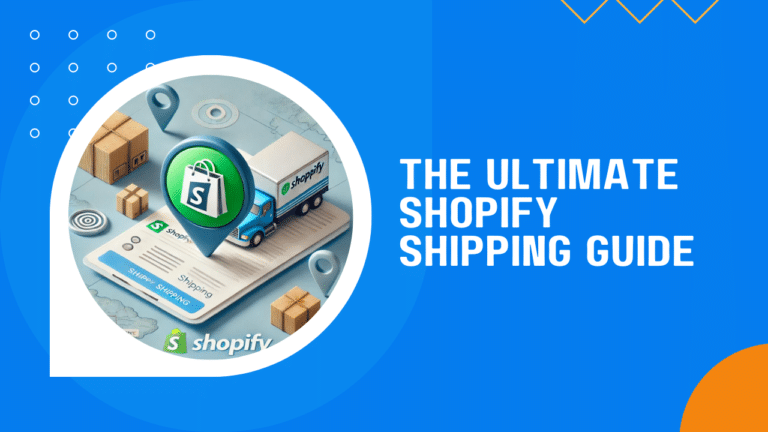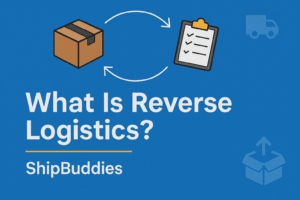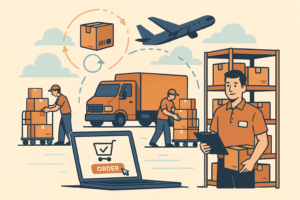Shipping is a key part of running a successful Shopify store. How you handle shipping can influence costs, delivery times, and customer satisfaction. Whether you’re just starting with Shopify or looking to improve your shipping setup, understanding Shopify’s built-in shipping tools is crucial.
In this guide, we’ll explore everything about Shopify Shipping—from setting up your shipping options to using advanced features that can save you money and keep your customers happy. By the end, you’ll be ready to optimize your shipping strategy and make the most of what Shopify has to offer.
Introduction to Shopify Shipping
Shopify Shipping is a full service shipping solution that simplifies how you manage shipping for your online store. Integrated directly into all Shopify plans, it allows you to handle everything from setting shipping rates to printing labels, all within the Shopify dashboard. This makes it easier to streamline your shipping process, save time, and even reduce costs.

One of the biggest advantages of using Shopify Shipping is access to discounted shipping rates from major shipping carriers like USPS, UPS, and DHL Express. These discounts are automatically applied, meaning you can offer competitive shipping rates to your customers without cutting into your profits. Additionally, Shopify Shipping supports multiple carriers, giving you the flexibility to choose the best option for each order.
Another benefit is the ease of use. Shopify Shipping is designed to be user-friendly, even for those new to ecommerce. You can set up everything quickly, from defining shipping zones to printing labels, allowing you to focus more on growing your business and less on the complexities of logistics.
Shipping insurance, providing protection against loss, theft, and damage, is also included with Shopify Shipping.
In the following sections, we’ll dive deeper into how to set up and optimize your Shopify Shipping, helping you make the most of this essential tool.
Setting Up Shopify Shipping
Getting your Shopify Shipping set up correctly is the foundation of an effective shipping strategy. This section will guide you through the essential steps to configure your shipping settings within Shopify.
Step 1: Set Up Shipping Locations and Zones
The first step in setting up Shopify Shipping is to define your shipping locations and zones. Shipping locations refer to the places where you store and ship your products, such as warehouses or fulfillment centers. Accurately setting up these locations ensures that shipping rates and options are calculated correctly for your customers.
Next, you’ll need to configure shipping zones, which are geographic regions that determine where your products can be shipped and the rates you charge for each region. For example, you can create different zones for domestic and international shipping. Setting up shipping zones allows you to tailor your shipping strategy to different markets, ensuring customers get the best rates and delivery times based on their location.
How to Set Up Shipping Locations and Zones in Shopify:
- Go to your Shopify admin and navigate to Settings > Shipping and delivery.
- Under Shipping section, click Manage next to the location you want to set up.
- Define your shipping zones by selecting Create shipping zone and adding the regions where you want to ship.
- Assign specific shipping rates to each zone based on your strategy.
Step 2: Configure Shipping Rates
Once your shipping zones are set up, the next step is to configure your shipping rates. Shopify offers several options for setting shipping rates:
- Flat-Rate Shipping: Charge a fixed shipping rate for all orders within a specific zone. This is ideal if your products have similar sizes and weights.
- Free Shipping: Attract more customers by offering free shipping, either for all orders or for orders that meet a certain price threshold.
- Calculated Shipping Rates: Use real-time carrier rates to charge customers based on the actual cost of shipping. This option is best when your products vary significantly in size and weight.
Choosing the right shipping rate strategy depends on your business model and customer expectations. For example, flat-rate shipping simplifies the checkout process, while calculated rates ensure accuracy based on the specifics of each order.

How to Configure Shipping Rates in Shopify:
- In your Shopify admin, go to Settings > Shipping and delivery.
- Select Manage rates next to the shipping profile you want to edit.
- Add a new rate by clicking Add rate under the relevant shipping zone.
- Choose between flat-rate, free shipping, or calculated rates based on your needs.
- Save your settings to apply the rates to your store.
Step 3: Print Shipping Labels
After setting up your shipping rates, it’s time to streamline your order fulfillment process by printing shipping labels directly from Shopify. This feature not only saves time but also helps you avoid errors by automatically using the customer’s shipping information.
Shopify allows you to print labels one by one or in bulk, making it easy to manage both small and large volumes of orders. You can also set up label printers and connect them to your Shopify account for quick and efficient printing.
How to Print Shipping Labels in Shopify:
- Go to Orders in your Shopify admin and select the order you want to fulfill.
- Click Create shipping label and review the shipping details.
- Adjust the package dimensions and weight if necessary. (You can use our free dimensional weight calculator to help determine the best packaging for your products.)
- Choose the shipping service and click Buy shipping label.
- Print the label and attach it to your package.
Step 4: Package and Ship Orders
The final step in the setup process is to package your orders according to carrier requirements and ship them out. Proper packaging not only protects your products but also ensures they meet carrier guidelines, avoiding delays or additional fees.
Depending on the carrier you use, you can either schedule a pickup from your location or drop off the packages at a designated location. Shopify Shipping integrates with major carriers like USPS, UPS, and DHL, making it easy to manage these logistics from within your Shopify admin.
Packaging and Shipping Orders:
- Choose packaging materials that meet the requirements of your selected carrier.
- Securely pack your items, ensuring they are well-protected during transit.
- Attach the printed shipping label to the package.
- Schedule a pickup through Shopify or drop off the package at the carrier’s location.
By following these steps, you’ll have a solid foundation for managing your shipping with Shopify. The next section will cover advanced tips to further optimize your shipping strategy.
Advanced Shopify Shipping Tips
Once you’ve set up the basics of Shopify Shipping, it’s time to take your shipping strategy to the next level. This section will explore advanced tips and techniques to help you reduce costs, improve delivery times, and streamline your operations.
Optimizing Shipping Costs
Shipping costs can significantly impact your bottom line, so it’s essential to optimize them wherever possible. Shopify offers several tools to help you minimize these costs:
- Leverage Shopify’s Discounted Rates: Shopify partners with major carriers like USPS, UPS, and DHL to offer discounted shipping rates. These savings are automatically applied when you purchase shipping labels through Shopify, allowing you to pass these lower costs onto your customers or improve your profit margins.
- Strategically Offer Free Shipping: Free shipping is a powerful incentive for customers, but it needs to be used wisely to avoid eating into your profits. Consider offering free shipping on orders above a certain value, which encourages larger purchases while covering the shipping cost within the product pricing.
- Incorporate Shipping Costs into Product Prices: Another strategy is to include a portion of the shipping cost in the product price, allowing you to offer “free” shipping without significantly impacting your profit margins. This approach works particularly well when customers expect free shipping as a standard offering.
International Shipping with Shopify
Expanding your business to international markets can open up new revenue streams, but it also introduces complexities like customs, duties, and taxes. Shopify provides tools to help you navigate these challenges:
- Understand Customs and Duties: When shipping internationally, it’s crucial to understand the customs and duties that may apply to your products in different countries. Shopify’s shipping settings allow you to display these costs at checkout, so customers aren’t surprised by unexpected fees when their order arrives.
- Use Shopify’s International Shipping Tools: Shopify offers features that streamline cross-border shipping, such as support for international carriers and automated customs forms. These tools help ensure that your international shipments are processed smoothly, reducing the risk of delays or returns.
- Set Up International Shipping Zones: Customize your shipping zones to include specific countries or regions, allowing you to tailor your shipping options and rates based on the destination. For instance, you can offer expedited shipping to countries where you have a large customer base, while using more economical options for less frequent destinations.
Utilizing Third-Party Shipping Apps
While Shopify Shipping provides robust tools, there are times when third-party apps can enhance your shipping capabilities, especially as your business grows:
- Multi-Carrier Support: If you ship a high volume of orders or need more advanced shipping features, consider using third-party apps that integrate with Shopify to support multiple carriers. These apps can offer additional features like automated rate shopping, which compares rates from different carriers to find the best deal for each shipment.
- Automated Label Printing: Third-party apps can also streamline your workflow by automating label printing, especially if you handle large volumes of orders. These apps allow you to print labels in bulk, saving time and reducing errors.
- Shopify Fulfillment Network: For businesses looking to scale, Shopify Fulfillment Network (SFN) offers a comprehensive solution that includes storage, packing, and shipping. SFN integrates seamlessly with your Shopify store, enabling fast and reliable delivery across the U.S. and beyond, while letting you maintain control over your brand and customer experience.
By implementing these advanced strategies, you can further optimize your Shopify Shipping setup, ensuring that it not only meets your current needs but also supports your business as it grows and expands into new markets. The next section will cover common shipping challenges and practical solutions to overcome them.
Common Shipping Challenges and How to Overcome Them
Even with a well-optimized shipping strategy, you may encounter challenges that can disrupt your operations and impact customer satisfaction. This section will address some of the most common shipping issues faced by Shopify merchants and provide practical solutions to overcome them.
Issue 1: Shipping Delays
Shipping delays are a common problem, especially during peak seasons like the holidays. Delays can lead to frustrated customers and increased support inquiries, so it’s important to manage them proactively.
How to Overcome Shipping Delays:
- Communicate with Customers: Transparency is key when dealing with potential delays. Use Shopify’s built-in email notifications to keep customers informed about their order status. If a delay occurs, send a personalized update explaining the situation and providing an estimated new delivery date.
- Select Faster Shipping Options During Peak Seasons: To mitigate the risk of delays during high-demand periods, consider offering expedited shipping options. While these options may be more expensive, they can ensure timely delivery and maintain customer satisfaction during critical times.
- Buffer Your Delivery Estimates: Add a buffer to your delivery estimates, especially when using standard shipping methods. This can help set more accurate customer expectations and reduce the likelihood of complaints if there’s a slight delay.
Issue 2: Managing Returns
Returns are an inevitable part of ecommerce, but they can be costly and time-consuming if not managed efficiently. A smooth return process not only reduces headaches for your business but also enhances customer trust and loyalty.
How to Overcome Return Challenges:
- Set Up a Clear Return Policy: Make sure your return policy is easy to understand and prominently displayed on your website. Outline the conditions under which returns are accepted, the time frame for returns, and the process customers should follow to initiate a return. Shopify allows you to customize return policies and display them during the checkout process. You can use our free return policy generator to help get you started.
- Use Shopify’s Return Features: Shopify offers tools to streamline returns, such as automated return labels and return management apps. These features simplify the return process for both you and your customers, ensuring that returns are handled quickly and efficiently.
- Minimize Returns with Accurate Product Descriptions: One of the best ways to reduce returns is to prevent them in the first place. Provide detailed and accurate product descriptions, including sizing information, material details, and clear images. This helps customers make informed purchasing decisions, reducing the likelihood of returns due to unmet expectations. Check out our AI product description generator to help you create accurate and complete product descriptions.
Issue 3: Shipping Costs Eating into Profits
Shipping costs can be a significant expense, and if not managed properly, they can erode your profit margins. Balancing competitive shipping rates with maintaining profitability is a common challenge for many Shopify merchants.
How to Overcome High Shipping Costs:
- Offer Free Shipping Strategically: While free shipping is attractive to customers, it can be costly for your business. Consider offering free shipping only on orders that exceed a certain value. This encourages larger purchases, helping to offset the cost of shipping.
- Use Real-Time Carrier Calculations: Shopify’s real-time carrier shipping feature allows you to charge customers exactly what it costs to ship their order, based on their location and the weight and dimensions of their purchase. This ensures that you’re not undercharging for shipping and helps maintain your margins.
- Negotiate Rates with Carriers: If you’re shipping a high volume of orders, you may be able to negotiate better rates with carriers. Contact your preferred carriers to discuss your shipping needs and explore options for discounted rates based on your shipping volume.
Addressing these common shipping challenges will allow you to improve the efficiency of your shipping process and enhance your customers’ experience.
Using a Third-Party Logistics (3PL) Provider Like ShipBuddies for Shipping and Order Fulfillment
As your Shopify store expands, managing shipping and fulfillment in-house can become increasingly complex and time-consuming. For many merchants, outsourcing these tasks to a reliable third-party fulfillment service provider is an efficient and cost-effective solution. This section will explore the benefits of using a 3PL like ShipBuddies, which specializes in Shopify order fulfillment services, for shipping and fulfillment, and how to determine if it’s the right move for your business.
Benefits of Using a 3PL like ShipBuddies
Outsourcing shipping and fulfillment to a 3PL offers several key advantages:
- Scalability: Third-party fulfillment partners are equipped to handle large volumes of orders, allowing your business to scale without the need for additional warehousing space or staff. This flexibility is particularly valuable during peak seasons when order volumes surge.
- Cost Efficiency: With their established relationships with major carriers, third-party logistics companies can secure competitive shipping rates, helping you reduce costs. Additionally, by outsourcing fulfillment, you can lower overhead expenses, eliminating the need to manage your own warehouses.
- Expertise and Technology: 3PLs specializes in logistics and employ advanced technology to streamline your entire shipping process. This includes inventory management, real-time tracking, and automated order processing, which enhances both accuracy and efficiency.
- Focus on Core Business: Partnering with a 3PL like ShipBuddies allows you to focus on other critical aspects of your business, such as product development and customer engagement, while leaving the complexities of fulfillment to experienced professionals.
Choosing the Right 3PL Provider
Selecting the right 3PL partner is crucial to ensuring a smooth and successful fulfillment process. When evaluating providers, consider the following factors:
- Services Offered: Ensure the 3PL offers the services you need, such as warehousing, order fulfillment, and returns management. Do they also provide value-added services like custom packaging, which can enhance your brand’s presentation?
- Technology Integration: Reliable fulfillment services will integrate seamlessly with popular platforms like Shopify, enabling automatic order syncing, real-time inventory updates, and detailed tracking information. This integration is essential for maintaining control over your fulfillment operations.
- Geographic Reach: Logistics companies have a network of warehouses that can help reduce shipping times and costs by fulfilling orders from locations closer to your customers, both domestically and internationally.
- Reputation and Reliability: Research the provider’s track record. ShipBuddies prides itself on its reliability, with a strong history of on-time deliveries and accurate order fulfillment, backed by positive client testimonials.
- Cost Structure: Understand the 3PL’s pricing model, including setup, storage, and fulfillment fees. ShipBuddies offers transparent pricing, ensuring that you can accurately budget your fulfillment costs without hidden surprises.
Transitioning to ShipBuddies
If you decide to transition to a dedicated fulfillment service, planning is key to avoiding disruptions. Here’s how to ensure a smooth transition:
- Assess Your Needs: Determine the volume of orders, product types, and specific fulfillment requirements you’ll outsource. This helps fulfillment companies tailor their services to meet your exact needs.
- Set Up Integration: ShipBuddies’ team will assist you in integrating their system with your Shopify store, ensuring seamless order syncing and fulfillment.
- Transfer Inventory: Coordinate with ShipBuddies to transfer your inventory to their warehouses, ensuring continuous stock monitoring to prevent any gaps in availability.
- Test the Process: Conduct test orders to verify that ShipBuddies’ fulfillment process aligns with your standards before fully committing to the partnership.
- Communicate with Customers: Inform your customers of any changes, such as updated shipping times or tracking methods. Clear communication helps maintain trust during the transition.
By partnering with a third-party logistics partner, you can streamline your operations, reduce shipping costs, and focus on growing your business. This approach not only supports your current needs but also positions your store for long-term success as it scales. The next section will recap the importance of continually assessing and refining your shipping strategy to ensure it evolves alongside your business growth.
Final Thoughts: Elevate Your Shopify Shipping Strategy
An effective shipping strategy is more than just getting products from point A to point B—it’s a critical component of your overall ecommerce success. By mastering Shopify’s built-in shipping tools, optimizing costs, and considering the benefits of partnering with a 3PL provider like ShipBuddies, you can enhance customer satisfaction, reduce expenses, and streamline your operations.
Remember, shipping is not a set-it-and-forget-it aspect of your business. As your store grows, your shipping needs will evolve. Continually assess and refine your shipping strategy, leveraging the tips and tools discussed in this guide to stay competitive and keep your customers happy.
Whether you’re just starting out or looking to optimize an established operation, the key is to remain proactive, adaptable, and customer-focused. By doing so, you’ll not only improve your shipping process but also support the long-term growth and sustainability of your Shopify store.
Frequently Asked Questions About Shopify Shipping
Does Shopify pay for shipping?
No, Shopify does not pay for shipping. However, Shopify offers discounted shipping rates through its Shopify Shipping service. These discounts are available from major carriers like USPS, UPS, and DHL, which can help reduce your shipping costs. When you purchase shipping labels through Shopify, you benefit from these lower rates, but the cost is still your responsibility.
Can you ship with FedEx using Shopify Shipping?
No. As of now, Shopify Shipping does not directly support FedEx. However, you can still use FedEx for your shipments by integrating a third-party app with your Shopify store. These apps allow you to manage FedEx shipping, print labels, and track shipments from within your Shopify admin, providing a seamless experience similar to using Shopify’s supported carriers.
What is the cost of Shopify Shipping?
The cost of using Shopify Shipping depends on the shipping rates for each order, which vary based on the carrier, shipping method, package size, and destination. Shopify does not charge extra fees for using its shipping service; you only pay for the shipping labels you purchase. The discounted rates provided by Shopify Shipping can help lower your overall shipping costs, making it a cost-effective option for many merchants.







